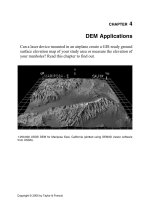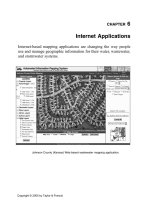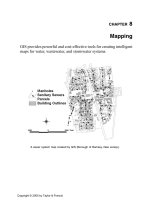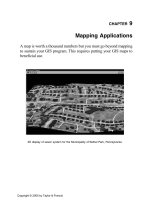Decision support and BI systems chapter 02
Bạn đang xem bản rút gọn của tài liệu. Xem và tải ngay bản đầy đủ của tài liệu tại đây (390.64 KB, 42 trang )
Decision Support and
Business Intelligence
Systems
(9th Ed., Prentice Hall)
Chapter 2:
Decision Making, Systems,
Modeling, and Support
Learning Objectives
Understand the conceptual foundations
of decision making
Understand the need for and the nature
of models in decision making
Understand Simon's four phases of
decision making:
2-2
intelligence,
design,
choice, and
implementation
Copyright © 2011 Pearson Education, Inc. Publishing as Prentice Hall
Learning Objectives
2-3
Recognize the concepts of rationality and
bounded rationality and how they relate
to decision making
Differentiate between the concepts of
making a choice and establishing a
principle of choice
Learn how DSS provide support for
decision making in practice
Understand the systems approach
Copyright © 2011 Pearson Education, Inc. Publishing as Prentice Hall
Opening Vignette:
“Decision Modeling at HP Using
Spreadsheets”
Company background
Problem
Proposed solution
Results
Answer and discuss the case
questions
2-4
Copyright © 2011 Pearson Education, Inc. Publishing as Prentice Hall
Decision Support Systems (DSS)
Dissecting DSS
into its main
concepts
Building successful
DSS requires a
through
understanding of
these concepts
2-5
Copyright © 2011 Pearson Education, Inc. Publishing as Prentice Hall
Characteristics of Decision
Making
2-6
Groupthink
Evaluating what-if scenarios
Experimentation with a real system!
Changes in the decision-making
environment may occur continuously
Time pressure on the decision maker
Analyzing a problem takes
time/money
Insufficient or too much information
Copyright © 2011 Pearson Education, Inc. Publishing as Prentice Hall
Characteristics of Decision
Making
Better decisions
Fast decision may be detrimental
Areas suffering most from fast
decisions
2-7
Tradeoff: accuracy versus speed
personnel/human resources (27%)
budgeting/finance (24%)
organizational structuring (22%)
quality/productivity (20%)
IT selection and installation (17%)
process improvement (17%)
Copyright © 2011 Pearson Education, Inc. Publishing as Prentice Hall
Decision Making
A process of choosing among two or
more alternative courses of action for
the purpose of attaining a goal(s)
Managerial decision making is
synonymous with the entire
management process
- Simon (1977)
e.g., Planning
2-8
What should be done? When? Where?
Why? How? By whom?
Copyright © 2011 Pearson Education, Inc. Publishing as Prentice Hall
Decision Making and Problem
Solving
A problem occurs when a system
2-9
does not meet its established goals
does not yield the predicted results,
or
does not work as planned
Problem is the difference between
the desired and actual outcome
Problem solving also involves
identification of new opportunities
Copyright © 2011 Pearson Education, Inc. Publishing as Prentice Hall
Decision Making and Problem
Solving
Are problem solving and decision making
different? Or, are they the same thing?
Consider phases of the decision process
Phase (1) Intelligence
Phase (2) Design
Phase (3) Choice, and
Phase (4) Implementation
(1)-(4): problem solving; (3): decision making
(1)-(3): decision making; (4): problem solving
2-10
This book: decision making ≅ problem
solving
Copyright © 2011 Pearson Education, Inc. Publishing as Prentice Hall
Decision-Making Disciplines
2-11
Behavioral: anthropology, law, philosophy,
political science, psychology, social
psychology, and sociology
Scientific: computer science, decision
analysis, economics, engineering, the hard
sciences (e.g., biology, chemistry, physics),
management science/operations research,
mathematics, and statistics
Each discipline has its own set of
assumptions and each contributes a unique,
valid view of how people make decisions
Copyright © 2011 Pearson Education, Inc. Publishing as Prentice Hall
Decision Style
The manner by which decision
makers think and react to problems
When making decisions, people…
2-12
perceive a problem
cognitive response
values and beliefs
follow different steps/sequence
give different emphasis, time
allotment, and priority to each steps
Copyright © 2011 Pearson Education, Inc. Publishing as Prentice Hall
Decision Style
Personality temperament tests are
often used to determine decision styles
There are many such tests
2-13
Meyers/Briggs,
True Colors (Birkman),
Keirsey Temperament Theory, …
Various tests measure somewhat
different aspects of personality
They cannot be equated!
Copyright © 2011 Pearson Education, Inc. Publishing as Prentice Hall
Decision Style
Decision-making styles
A successful computerized system
should fit the decision style and the
decision situation
2-14
Heuristic versus Analytic
Autocratic versus Democratic
Consultative (with individuals or groups)
Should be flexible and adaptable to
different users (individuals vs. groups)
Copyright © 2011 Pearson Education, Inc. Publishing as Prentice Hall
Decision Makers
Small organizations
Medium-to-large organizations
2-15
Individuals
Conflicting objectives
Groups
Different styles, backgrounds,
expectations
Conflicting objectives
Consensus is often difficult to reach
Help: Computer support, GSS, …
Copyright © 2011 Pearson Education, Inc. Publishing as Prentice Hall
Model
2-16
A significant part of many DSS and BI
systems
A model is a simplified representation
(or abstraction) of reality
Often, reality is too complex to describe
Much of the complexity is actually
irrelevant in solving a specific problem
Models can represent systems/problems
at various degrees of abstraction
Copyright © 2011 Pearson Education, Inc. Publishing as Prentice Hall
Types of Models
Models can be classified based on
their degree of abstraction
Degree of
abstraction
Less
Iconic models (scale models)
Analog models
Mental Models
Mathematical (quantitative) models
More
2-17
Copyright © 2011 Pearson Education, Inc. Publishing as Prentice Hall
The Benefits of Models
2-18
Ease of manipulation
Compression of time
Lower cost of analysis on models
Cost of making mistakes on
experiments
Inclusion of risk/uncertainty
Evaluation of many alternatives
Reinforce learning and training
Web is source and a destination for it
Copyright © 2011 Pearson Education, Inc. Publishing as Prentice Hall
Phases of Decision-Making
Process
Humans consciously or sub
consciously follow a systematic
decision-making process
- Simon (1977)
1)
2)
3)
4)
5)
2-19
Intelligence
Design
Choice
Implementation
(?) Monitoring (a part of intelligence?)
Copyright © 2011 Pearson Education, Inc. Publishing as Prentice Hall
Simon’s Decision-Making Process
2-20
Copyright © 2011 Pearson Education, Inc. Publishing as Prentice Hall
Decision-Making: Intelligence
Phase
Scan the environment, either intermittently
or continuously
Identify problem situations or opportunities
Monitor the results of the implementation
Problem is the difference between what
people desire (or expect) and what is
actually occurring
2-21
Symptom versus Problem
Timely identification of opportunities is as
important as identification of problems
Copyright © 2011 Pearson Education, Inc. Publishing as Prentice Hall
Decision-Making: Intelligence
Phase
Potential issues in data/information
collection and estimation
2-22
Lack of data
Cost of data collection
Inaccurate and/or imprecise data
Data estimation is often subjective
Data may be insecure
Key data may be qualitative
Data change over time (timedependence)
Copyright © 2011 Pearson Education, Inc. Publishing as Prentice Hall
Decision-Making: Intelligence
Phase
Problem Classification
Problem Decomposition
Classification of problems according to the
degree of structuredness
Often solving the simpler subproblems may
help in solving a complex problem
Information/data can improve the
structuredness of a problem situation
Problem Ownership
A Formal
Problem
Outcome of intelligence phase:
Statement
2-23
Copyright © 2011 Pearson Education, Inc. Publishing as Prentice Hall
Decision-Making: The Design
Phase
Finding/developing and analyzing possible
courses of actions
A model of the decision-making problem is
constructed, tested, and validated
Modeling: conceptualizing a problem and
abstracting it into a quantitative and/or
qualitative form (i.e., using
symbols/variables)
2-24
Abstraction: making assumptions for simplification
Tradeoff (cost/benefit): more or less abstraction
Modeling: both an art and a science
Copyright © 2011 Pearson Education, Inc. Publishing as Prentice Hall
Decision-Making: The Design
Phase
Selection of a Principle of Choice
It is a criterion that describes the
acceptability of a solution approach
Reflection of decision-making
objective(s)
In a model, it is the result variable
Choosing and validating against
2-25
High-risk versus low-risk
Optimize versus satisfice
Criterion is not a constraint
Copyright © 2011 Pearson Education, Inc. Publishing as Prentice Hall









